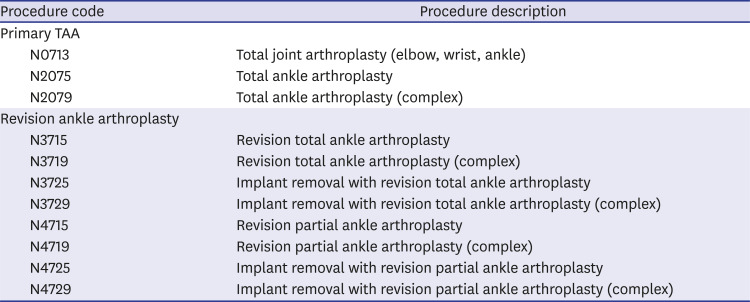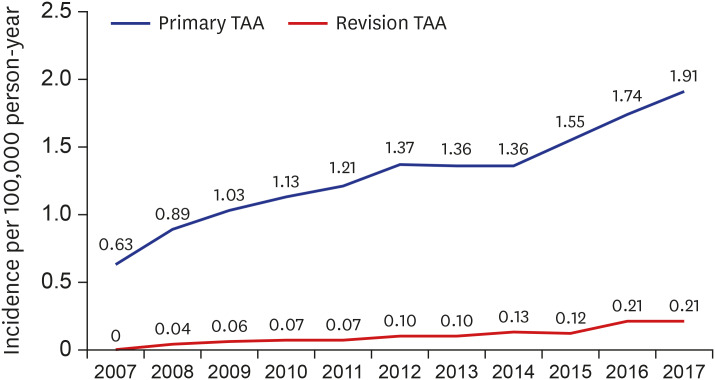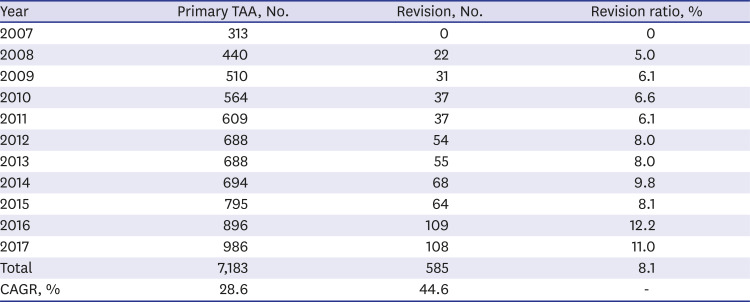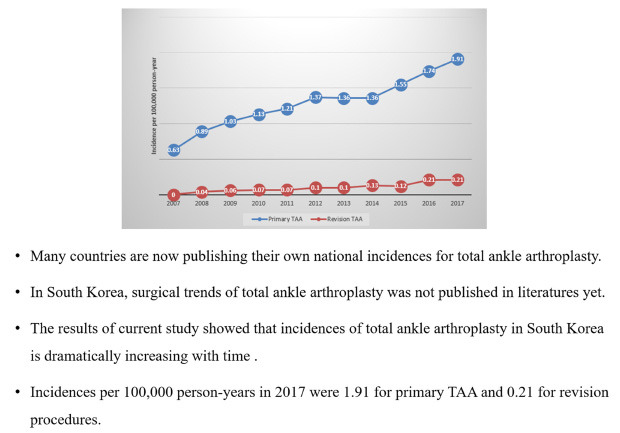1. Law TY, Sabeh KG, Rosas S, Hubbard Z, Altajar S, Roche MW. Trends in total ankle arthroplasty and revisions in the Medicare database. Ann Transl Med. 2018; 6(7):112. PMID:
29955572.

2. Ahmad J, Raikin SM. Ankle arthrodesis: the simple and the complex. Foot Ankle Clin. 2008; 13(3):381–400. PMID:
18692006.

3. Kim JG, Ha DJ, Gwak HC, Kim CW, Kim JH, Lee SJ, et al. Ankle arthrodesis: a comparison of anterior approach and transfibular approach. Clin Orthop Surg. 2018; 10(3):368–373. PMID:
30174814.

4. Coester LM, Saltzman CL, Leupold J, Pontarelli W. Long-term results following ankle arthrodesis for post-traumatic arthritis. J Bone Joint Surg Am. 2001; 83(2):219–228. PMID:
11216683.

5. Stavrakis AI, SooHoo NF. Trends in complication rates following ankle arthrodesis and total ankle replacement. J Bone Joint Surg Am. 2016; 98(17):1453–1458. PMID:
27605689.

6. Matsumoto T, Yasunaga H, Matsui H, Fushimi K, Izawa N, Yasui T, et al. Time trends and risk factors for perioperative complications in total ankle arthroplasty: retrospective analysis using a national database in Japan. BMC Musculoskelet Disord. 2016; 17(1):450. PMID:
27793137.

7. Lai WC, Arshi A, Ghorbanifarajzadeh A, Williams JR, Soohoo NF. Incidence and predictors of early complications following primary and revision total ankle arthroplasty. Foot Ankle Surg. 2019; 25(6):785–789. PMID:
30467054.

8. Pugely AJ, Lu X, Amendola A, Callaghan JJ, Martin CT, Cram P. Trends in the use of total ankle replacement and ankle arthrodesis in the United States Medicare population. Foot Ankle Int. 2014; 35(3):207–215. PMID:
24177759.

9. Vulcano E, Myerson MS. The painful total ankle arthroplasty: a diagnostic and treatment algorithm. Bone Joint J. 2017; 99-B(1):5–11. PMID:
28053250.
10. Thomas RH, Daniels TR. Ankle arthritis. J Bone Joint Surg Am. 2003; 85(5):923–936. PMID:
12728047.

11. Zaidi R, Cro S, Gurusamy K, Siva N, Macgregor A, Henricson A, et al. The outcome of total ankle replacement: a systematic review and meta-analysis. Bone Joint J. 2013; 95-B(11):1500–1507. PMID:
24151270.
12. Skyttä ET, Koivu H, Eskelinen A, Ikävalko M, Paavolainen P, Remes V. Total ankle replacement: a population-based study of 515 cases from the Finnish Arthroplasty Register. Acta Orthop. 2010; 81(1):114–118. PMID:
20180720.

13. Gadd RJ, Barwick TW, Paling E, Davies MB, Blundell CM. Assessment of a three-grade classification of complications in total ankle replacement. Foot Ankle Int. 2014; 35(5):434–437. PMID:
24532698.

14. Bonnin M, Gaudot F, Laurent JR, Ellis S, Colombier JA, Judet T. The Salto total ankle arthroplasty: survivorship and analysis of failures at 7 to 11 years. Clin Orthop Relat Res. 2011; 469(1):225–236. PMID:
20593253.

15. Rybalko D, Schwarzman G, Moretti V. Recent national trends and outcomes in total ankle arthroplasty in the United States. J Foot Ankle Surg. 2018; 57(6):1092–1095. PMID:
30030038.

16. Singh JA, Ramachandran R. Time trends in total ankle arthroplasty in the USA: a study of the national inpatient sample. Clin Rheumatol. 2016; 35(1):239–245. PMID:
24907036.

17. Seaworth CM, Do HT, Vulcano E, Mani SB, Lyman SL, Ellis SJ. Epidemiology of total ankle arthroplasty: trends in New York state. Orthopedics. 2016; 39(3):170–176. PMID:
27135448.

18. Jo YH, Lee BG, Kim JH, Lee CH, Kim SJ, Choi WS, et al. National surgical trends for distal radius fractures in Korea. J Korean Med Sci. 2017; 32(7):1181–1186. PMID:
28581277.

19. Raikin SM, Rasouli MR, Espandar R, Maltenfort MG. Trends in treatment of advanced ankle arthropathy by total ankle replacement or ankle fusion. Foot Ankle Int. 2014; 35(3):216–224. PMID:
24357680.

20. Clough T, Bodo K, Majeed H, Davenport J, Karski M. Survivorship and long-term outcome of a consecutive series of 200 Scandinavian total ankle replacement (STAR) implants. Bone Joint J. 2019; 101-B(1):47–54. PMID:
30601052.

21. Saltzman CL, Kadoko RG, Suh JS. Treatment of isolated ankle osteoarthritis with arthrodesis or the total ankle replacement: a comparison of early outcomes. Clin Orthop Surg. 2010; 2(1):1–7. PMID:
20190994.

22. Easley ME, Adams SB Jr, Hembree WC, DeOrio JK. Results of total ankle arthroplasty. J Bone Joint Surg Am. 2011; 93(15):1455–1468. PMID:
21915552.

23. Jeng CL, Campbell JT, Tang EY, Cerrato RA, Myerson MS. Tibiotalocalcaneal arthrodesis with bulk femoral head allograft for salvage of large defects in the ankle. Foot Ankle Int. 2013; 34(9):1256–1266. PMID:
23650649.












 PDF
PDF Citation
Citation Print
Print






 XML Download
XML Download